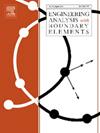AttenEpilepsy:基于多头自我注意的二维卷积网络模型
IF 4.2
2区 工程技术
Q1 ENGINEERING, MULTIDISCIPLINARY
Engineering Analysis with Boundary Elements
Pub Date : 2024-10-17
DOI:10.1016/j.enganabound.2024.105989
引用次数: 0
摘要
现有的癫痫检测模型在捕捉时频图像特征时,更多地关注局部信息,而不是真正意义上的长程依赖性。这导致特征向量提取不精确,检测精度有待优化。AttenEpilepsy 是一种新型的二维卷积网络模型,它利用多头自注意机制对单信道脑电信号的癫痫发作期、发作间期和健康状态进行分类。AttenEpilepsy 模型由两部分组成,即特征提取和时频上下文编码(STCE)。提出了一种结合多路径卷积和自适应混合特征重校准的特征提取方法,其中使用不同大小卷积核的多路径卷积从时频图像中提取相关的多尺度特征。STCE 包括两个模块:多头自注意和因果卷积。修改后的多头自注意机制用于对提取的时频特征建模,因果卷积用于分析时间相关性的频率信息。波恩大学癫痫研究中心的公共数据集被用来评估 AttenEpilepsy 模型的性能。实验结果表明,AtenEpilepsy 模型的准确度(AC)、灵敏度(SE)、特异度(SP)和 F1 分数(F1)分别达到了 99.81%、99.82%、99.89% 和 99.83%。通过在输入数据中引入各种噪声,对模型的鲁棒性进行了进一步测试。从各种评估指标来看,所提出的 AttenEpilepsy 网络模型都优于最先进的模型。本文章由计算机程序翻译,如有差异,请以英文原文为准。
AttenEpilepsy: A 2D convolutional network model based on multi-head self-attention
The existing epilepsy detection models focus more on local information than the true meaning of long-range dependence when capturing time–frequency image features. This results in imprecise feature vector extraction and room for optimization of detection accuracy. AttenEpilepsy is a novel 2D convolutional network model that uses a multi-head self-attention mechanism to classify epileptic seizure periods, inter-seizure periods, and health states of single-channel EEG signals. The AttenEpilepsy model consists of two parts, namely feature extraction and time–frequency context encoding (STCE). A feature extraction method combining multi-path convolution and adaptive hybrid feature recalibration is proposed, in which multi-path convolution with convolution kernels of different sizes is used to extract relevant multi-scale features from time–frequency images. STCE consists of two modules: multi-head self-attention and causal convolution. A modified multi-head self-attention mechanism is used to model the extracted time–frequency features, and causal convolution is used to analyse the frequency information on the time dependencies. A public dataset from the University of Bonn Epilepsy Research Center is used to evaluate the performance of the AttenEpilepsy model. The experimental results show that the AttenEpilepsy model achieved accuracy (AC), sensitivity (SE), specificity (SP), and F1 score (F1) of 99.81%, 99.82%, 99.89%, and 99.83%, respectively. Further testing of the robustness of the model is conducted by introducing various types of noise into the input data. The proposed AttenEpilepsy network model outperforms the state-of-the-art in terms of various evaluation metrics.
求助全文
通过发布文献求助,成功后即可免费获取论文全文。
去求助
来源期刊

Engineering Analysis with Boundary Elements
工程技术-工程:综合
CiteScore
5.50
自引率
18.20%
发文量
368
审稿时长
56 days
期刊介绍:
This journal is specifically dedicated to the dissemination of the latest developments of new engineering analysis techniques using boundary elements and other mesh reduction methods.
Boundary element (BEM) and mesh reduction methods (MRM) are very active areas of research with the techniques being applied to solve increasingly complex problems. The journal stresses the importance of these applications as well as their computational aspects, reliability and robustness.
The main criteria for publication will be the originality of the work being reported, its potential usefulness and applications of the methods to new fields.
In addition to regular issues, the journal publishes a series of special issues dealing with specific areas of current research.
The journal has, for many years, provided a channel of communication between academics and industrial researchers working in mesh reduction methods
Fields Covered:
• Boundary Element Methods (BEM)
• Mesh Reduction Methods (MRM)
• Meshless Methods
• Integral Equations
• Applications of BEM/MRM in Engineering
• Numerical Methods related to BEM/MRM
• Computational Techniques
• Combination of Different Methods
• Advanced Formulations.
 求助内容:
求助内容: 应助结果提醒方式:
应助结果提醒方式:


